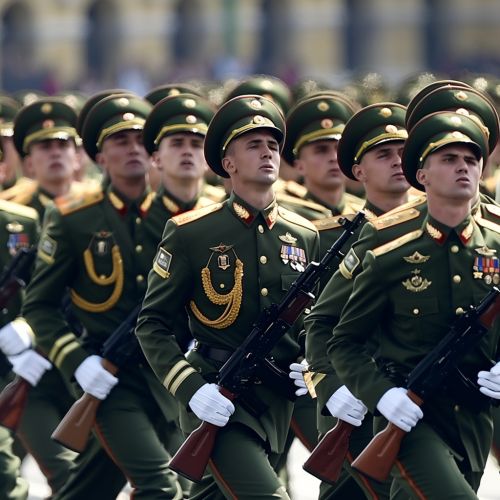Russian Army: Difference between revisions
(Created page with "== History == The Russian Army has a long and storied history, tracing its origins back to the early medieval period. The formation of the army can be linked to the Kievan Rus', a federation of Slavic tribes under the rule of the Varangians. The army evolved significantly over the centuries, particularly during the reign of Peter the Great, who modernized the military and established the Imperial Russian Army in the early 18th century. During the Napo...") |
No edit summary |
||
| (One intermediate revision by the same user not shown) | |||
| Line 13: | Line 13: | ||
The army is organized into military districts, each responsible for a specific geographic area. These districts include the Western, Southern, Central, and Eastern Military Districts. Each district is further divided into operational commands and units, allowing for efficient command and control. | The army is organized into military districts, each responsible for a specific geographic area. These districts include the Western, Southern, Central, and Eastern Military Districts. Each district is further divided into operational commands and units, allowing for efficient command and control. | ||
[[Image:Detail-93227.jpg|thumb|center|Russian troops in formation during a military parade.|class=only_on_mobile]] | |||
[[Image:Detail-93228.jpg|thumb|center|Russian troops in formation during a military parade.|class=only_on_desktop]] | |||
== Training and Education == | == Training and Education == | ||
Latest revision as of 04:43, 22 June 2024
History
The Russian Army has a long and storied history, tracing its origins back to the early medieval period. The formation of the army can be linked to the Kievan Rus', a federation of Slavic tribes under the rule of the Varangians. The army evolved significantly over the centuries, particularly during the reign of Peter the Great, who modernized the military and established the Imperial Russian Army in the early 18th century.
During the Napoleonic Wars, the Russian Army played a crucial role in the defeat of Napoleon Bonaparte, notably during the Battle of Borodino and the subsequent French retreat from Moscow. The 19th century saw further reforms, including the introduction of conscription and the establishment of military districts.
The Russian Revolution of 1917 led to the disbandment of the Imperial Russian Army and the creation of the Red Army by the Bolsheviks. The Red Army was instrumental in the Russian Civil War and later evolved into the Soviet Army. After the dissolution of the Soviet Union in 1991, the Russian Army was reconstituted as the armed forces of the Russian Federation.
Structure and Organization
The Russian Army is part of the Armed Forces of the Russian Federation and is divided into several branches, including the Ground Forces, Airborne Troops, and Special Operations Forces. The Ground Forces are the largest component, comprising various units such as infantry, armor, artillery, and engineering troops.
The army is organized into military districts, each responsible for a specific geographic area. These districts include the Western, Southern, Central, and Eastern Military Districts. Each district is further divided into operational commands and units, allowing for efficient command and control.


Training and Education
Training in the Russian Army is rigorous and comprehensive, focusing on both physical conditioning and specialized skills. Recruits undergo basic training, followed by advanced training specific to their assigned roles. The army operates several military academies, including the Frunze Military Academy and the General Staff Academy, which provide higher education and training for officers.
Conscription remains a key component of the Russian Army, with all male citizens required to serve for a period of one year. However, there is also a significant number of professional soldiers who serve on a contract basis.
Equipment and Technology
The Russian Army is equipped with a wide range of modern weaponry and technology. Key equipment includes the T-14 Armata main battle tank, the BMP-3 infantry fighting vehicle, and the S-400 air defense system. The army also utilizes advanced communication systems, drones, and electronic warfare capabilities.
The development and procurement of new technology are overseen by the Ministry of Defence and various state-owned enterprises, such as Rostec and Uralvagonzavod. These organizations are responsible for research, development, and production of military hardware.
Operations and Deployments
The Russian Army has been involved in numerous operations and deployments both domestically and internationally. Notable recent operations include the Second Chechen War, the Russo-Georgian War, and the intervention in the Syrian Civil War. The army also participates in various peacekeeping missions under the auspices of the United Nations and other international organizations.
Domestically, the army is often called upon to assist in disaster relief and emergency situations, such as the response to the 2010 Russian wildfires and the 2019 Siberian floods.
Modern Challenges and Reforms
The Russian Army faces several challenges in the modern era, including the need to modernize its equipment and infrastructure, address demographic issues affecting conscription, and counter emerging threats such as cyber warfare. In response, the government has implemented a series of reforms aimed at improving the efficiency and effectiveness of the military.
These reforms include the professionalization of the armed forces, increased investment in research and development, and the restructuring of military districts and units. Additionally, there has been a focus on improving the welfare and living conditions of soldiers, as well as enhancing training and education programs.
See Also
- Kievan Rus'
- Peter the Great
- Napoleonic Wars
- Russian Revolution
- Red Army
- Soviet Union
- Ground Forces
- Airborne Troops
- Special Operations Forces
- Frunze Military Academy
- General Staff Academy
- T-14 Armata
- BMP-3
- S-400
- Ministry of Defence
- Rostec
- Uralvagonzavod
- Second Chechen War
- Russo-Georgian War
- Syrian Civil War
- United Nations
- 2010 Russian wildfires
- 2019 Siberian floods
